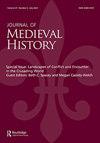贸易、口味和生态:中世纪晚期欧洲的蜂蜜
IF 0.3
2区 历史学
0 MEDIEVAL & RENAISSANCE STUDIES
引用次数: 1
摘要
摘要:这篇文章通常被认为是一种普遍存在且广泛可用的甜味剂,它代表了中世纪后期欧洲蜂蜜贸易的首次研究。在各种文化和社会因素的推动下,对蜂蜜的需求鼓励了国际贸易,到中世纪晚期,这种贸易横跨地中海、西大西洋、北海和波罗的海,将从贝鲁特到诺夫哥罗德的人民、贸易商和景观连接在一起。作为一种成分和味道受到生产环境和生态影响的天然产品,欧洲同时代人可获得的蜂蜜在味道、颜色和粘度方面可能存在显著差异,从而影响声誉、价格和社会价值。一项对中世纪晚期欧洲蜂蜜贸易的研究为文化发展、社会趋势、经济实践和政治事件如何影响一种广泛可用但多样化的商品的消费提供了新的线索。本文章由计算机程序翻译,如有差异,请以英文原文为准。
Trade, taste and ecology: honey in late medieval Europe
ABSTRACT Often considered a ubiquitous and widely available sweetener, this article represents the first study of the honey trade across Europe in the later Middle Ages. Demand for honey, fuelled by diverse cultural and social factors, encouraged an international trade that by the late medieval period spanned the Mediterranean, western Atlantic, and the North and Baltic Seas, connecting peoples, traders and landscapes from Beirut to Novgorod. As a natural product whose make up and taste was influenced by the environments and ecology in which it was produced, the honeys available to European contemporaries could vary significantly in taste, colour and viscosity, influencing reputation, price and societal value. A study of the honey trade in late medieval Europe sheds new light on how cultural developments, social trends, economic practicalities and political events influenced the consumption of a widely available but diverse commodity.
求助全文
通过发布文献求助,成功后即可免费获取论文全文。
去求助
来源期刊

JOURNAL OF MEDIEVAL HISTORY
MEDIEVAL & RENAISSANCE STUDIES-
CiteScore
0.60
自引率
0.00%
发文量
29
期刊介绍:
The Journal of Medieval History aims at meeting the need for a major international publication devoted to all aspects of the history of Europe in the Middle Ages. Each issue comprises around four or five articles on European history, including Britain and Ireland, between the fall of Rome and the Renaissance. The Journal also includes review articles, historiographical essays and state of research studies.
 求助内容:
求助内容: 应助结果提醒方式:
应助结果提醒方式:


